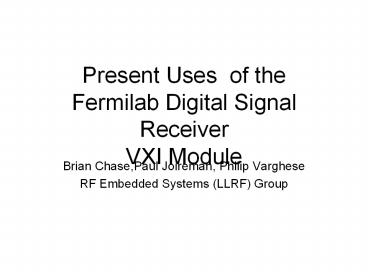Present Uses of the Fermilab Digital Signal Receiver VXI Module - PowerPoint PPT Presentation
Title:
Present Uses of the Fermilab Digital Signal Receiver VXI Module
Description:
Present Uses of the Fermilab Digital Signal Receiver VXI Module Brian Chase,Paul Joireman, Philip Varghese RF Embedded Systems (LLRF) Group – PowerPoint PPT presentation
Number of Views:71
Avg rating:3.0/5.0
Title: Present Uses of the Fermilab Digital Signal Receiver VXI Module
1
Present Uses of the Fermilab Digital Signal
ReceiverVXI Module
- Brian Chase,Paul Joireman, Philip Varghese
- RF Embedded Systems (LLRF) Group
2
Digital Signal Receiver (DSR)
- 8 Channel Digital Receiver VXI Module
- 65 MSPS AD6644 ADCs with AD6620 DDC
- ADSP21062 Floating Point DSP
- Sync modes in 2 channel pairs
- External sample trigger, front panel or
back-plane for TBT mode - Differential inputs on DB15 connectors or SMB
option - Daughter card for each channel pair with DAC and
digital control - 4 12 bit DAC front panel outputs
- 130 dB dynamic range at /square root Hz
3
DSR Block Diagram
4
DSR Single Channel
5
(No Transcript)
6
DSR Operational Status
- Main Injector
- 53 MHz and 2.5 MHz radial position and beam phase
detection for LLRF beam control loops - ECBPMD (Recycler) - Development System
- H1 (89 kHz) BPM processing on four detectors for
over one year. - ECBPM (Wideband) - Operational System
- 32 kHz and pulse mode processing on 19 BPMs
7
MI DSR RPOS Measurements
8
Beam/Gain Changes
Pbar/high Elec/high Elec/low
Pbar/high
9
Intensity Changes
10
Pulsed Mode v. Pbar
Pulsed mode Pbar
11
Stretched Wire Measurements
12
Differential Non-linearity
13
Integral Non-linearity
14
Noise Measurements
100 Hz Bandwidth position data
Beam Type PreampGain 3s X axis (mm) 3s Y axis (mm)
Electron Low 34 37
High 15 9
Pbar Low 23 27
High 16 14
15
Noise Measurements
5 Hz Bandwidth position data
Beam Type PreampGain 3s X axis (mm) 3s Y axis (mm)
Electron Low 5 2
High 2 1
Pbar Low 3 1
High 1 1
16
ECBPM Hardware/Software Block Diagram
17
ECBPM/DSR Software Functionality
18
ECBPM Software Metrics
- Language C/C
- Operating System VxWorks 5.4
- Development Effort 3-4 man-months
- Lines of Code 10,000 (50 COM)
- Functions
- Manage DSR resources in VXI mainframe
- Provide Acnet/MOOC interface for reading/setting
and basic control of BPM system. - Provide high-level functionality to user to
configure system for different operational modes
19
DSR Shared Library Metrics
- Language C
- Operating System VxWorks 5.4
- Development Effort 2-3 man-months
- Lines of Code 6700 (60 COM)
- Functions
- Glue layer to support communication between
application software and DSR hardware. - Encapsulate DSR hardware using object-based
methodology. - Data DSP hardware addresses
- Methods
- Creation/initialization
- Informational - DsrDump, DsrParamInfo
- Client Vector Interrupts requests for DSP
services
20
DSP Software Metrics
- Language C and Assembly
- Operating System N/A
- Development Effort 3-4 man-months
- Lines of Code 4700 (50 COM)
- Functions
- Configure hardware in a default initial state
- Communication with DSR hardware external to DSP,
DDC (AD6620) chip, VXI reset line, and hardware
test points. - Low-level data processing and analysis including
acquisition, filtering and engineering
calculations.
21
TESTDSR Software Metrics
- Language C/C (LabView)
- Operating System VxWorks 5.4
- Development Effort 2 man-months
- Lines of Code 3000 (60 COM)
- Functions
- Test low-level hardware functionality of DSR
board - Five test modes
- Memory test, ADC test, Frequency sweep, Trim
Potentiometers, Power Sweep - Labview interface to control testing procedure
22
DSR, Tev Module Comparison
- Tev Module
- 5 MHz BW
- Analog position processing
- Intensity triggered position sample once per
turn. - No turn marker used.
- DSR
- ltlt1 MHz BW
- Digital position processing
- Intensity triggered once per turn or pure narrow
band - Turn marker is optional
23
Process Bandwidth Considerations
- Wideband gt 2 MHz
- Good SNR
- Systematic errors are hard to manage.
- Signal looks good but may have average error
- Narrow Band
- Good SNR with large fill factor
- Even with poor SNR, average is correct.
24
Trigger Options with DSR














![Global Digital Signal Processors [DSP] Market Forecast & Analysis (2011-2016) PowerPoint PPT Presentation](https://s3.amazonaws.com/images.powershow.com/6327373.th0.jpg?_=20190226012)
















